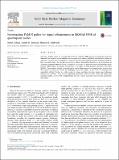Files in this item
Investigating FAM-N pulses for signal enhancement in MQMAS NMR of quadrupolar nuclei
Item metadata
| dc.contributor.author | Colaux, Henri | |
| dc.contributor.author | Dawson, Daniel M. | |
| dc.contributor.author | Ashbrook, Sharon E. | |
| dc.date.accessioned | 2017-09-08T12:30:08Z | |
| dc.date.available | 2017-09-08T12:30:08Z | |
| dc.date.issued | 2017-08 | |
| dc.identifier | 248478677 | |
| dc.identifier | 680719e4-023c-4ab3-82c5-05f4f839b483 | |
| dc.identifier | 85010569056 | |
| dc.identifier | 000410462800013 | |
| dc.identifier.citation | Colaux , H , Dawson , D M & Ashbrook , S E 2017 , ' Investigating FAM-N pulses for signal enhancement in MQMAS NMR of quadrupolar nuclei ' , Solid State Nuclear Magnetic Resonance , vol. 84 , pp. 89-102 . https://doi.org/10.1016/j.ssnmr.2017.01.001 | en |
| dc.identifier.issn | 0926-2040 | |
| dc.identifier.other | ORCID: /0000-0002-4538-6782/work/56638903 | |
| dc.identifier.other | ORCID: /0000-0002-8110-4535/work/34029109 | |
| dc.identifier.uri | https://hdl.handle.net/10023/11630 | |
| dc.description | The authors would like to thank EPSRC (EP/K503162/1) for the award of a studentship to HFC and the ERC (EU FP7 Consolidator Grant 614290 “EXONMR”) for support. SEA would also like to thank the Royal Society and Wolfson Foundation for a merit award. The UK 850 MHz solid-state NMR Facility used in this research was funded by EPSRC and BBSRC (contract reference PR140003), as well as the University of Warwick including via part funding through Birmingham Science City Advanced Materials Projects 1 and 2 supported by Advantage West Midlands (AWM) and the European Regional Development Fund (ERDF). Financial support from the TGIR-RMN-THC Fr3050 CNRS to access the 800 MHz spectrometer (Lille) is gratefully acknowledged. | en |
| dc.description.abstract | Although a popular choice for obtaining high-resolution solid-state NMR spectra of quadrupolar nuclei, the inherently low sensitivity of the multiple-quantum magic-angle spinning (MQMAS) experiment has limited its application for nuclei with low receptivity or when the available sample volume is limited. A number of methods have been introduced in the literature to attempt to address this problem. Recently, we have introduced an alternative, automated approach, based on numerical simulations, for generating amplitude-modulated pulses (termed FAM-N pulses) to enhance the efficiency of the triple- to single-quantum conversion step within MQMAS. This results in efficient pulses that can be used without experimental reoptimisation, ensuring that this method is particularly suitable for challenging nuclei and systems. In this work, we investigate the applicability of FAM-N pulses to a wider variety of systems, and their robustness under more challenging experimental conditions. These include experiments performed under fast MAS, nuclei with higher spin quantum numbers, samples with multiple distinct sites, low-γ nuclei and nuclei subject to large quadrupolar interactions. | |
| dc.format.extent | 1502971 | |
| dc.language.iso | eng | |
| dc.relation.ispartof | Solid State Nuclear Magnetic Resonance | en |
| dc.subject | Solid-state MAS NMR spectroscopy | en |
| dc.subject | MQMAS | en |
| dc.subject | Quadrupolar nuclei | en |
| dc.subject | Fast-amplitude modulation | en |
| dc.subject | FAM-N pulses | en |
| dc.subject | Challenging systems | en |
| dc.subject | QD Chemistry | en |
| dc.subject | DAS | en |
| dc.subject.lcc | QD | en |
| dc.title | Investigating FAM-N pulses for signal enhancement in MQMAS NMR of quadrupolar nuclei | en |
| dc.type | Journal article | en |
| dc.contributor.sponsor | European Research Council | en |
| dc.contributor.institution | University of St Andrews. School of Chemistry | en |
| dc.contributor.institution | University of St Andrews. EaSTCHEM | en |
| dc.identifier.doi | https://doi.org/10.1016/j.ssnmr.2017.01.001 | |
| dc.description.status | Peer reviewed | en |
| dc.identifier.grantnumber | 614290 - EXONMR | en |
This item appears in the following Collection(s)
Items in the St Andrews Research Repository are protected by copyright, with all rights reserved, unless otherwise indicated.

